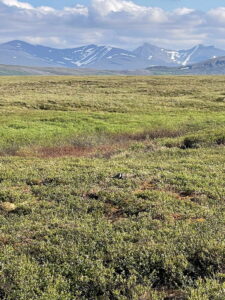
A kōlea on the Nome tundra. ©Susan Scott
July 8, 2024
Hawaiʻi walks are always good, but not quite as good from May through July, when our kōlea are in Alaska. We plover lovers feel the birds’ absence, and often wonder how they’re doing with their summer job of chick-rearing.
Some of us went to see for ourselves From June 24-28, the Hawaiʻi Audubon Society sponsored its second Kōlea Quest trip to Nome. And once again, we had the privilege of accompanying world plover authority, Dr. O. Wally Johnson, and his two research associates from Anchorage. (Photo below. Wally, brown coat, in center.)
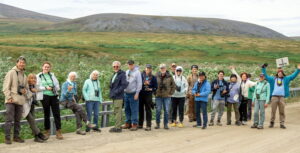
©Laura Doucette
For Hawaiʻi residents accustomed to friendly kōlea that prance around our backyards and eat scrambled eggs on our lanais, Alaska kōlea hold a surprise: While breeding, the birds view humans as predators, up there with foxes, ravens, jaegers, and all the other Arctic animals hunting for food. With predators on the prowl for nutritious eggs and chicks, the lives of plovers, and all ground-nesting birds on the tundra, are filled with life-and-death drama. Camouflage, hunkering down, and holding motionlessness are keys to survival, making finding even one kōlea nest a challenge.
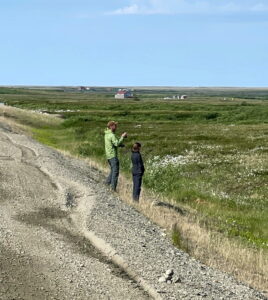
Wally’s long-time field workers, Paul and Nancy Brusseau, scouting for kōlea. ©Susan Scott
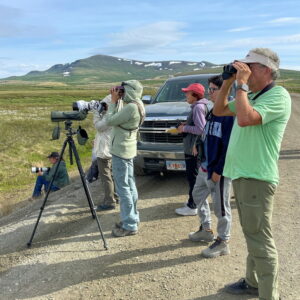
Members of our group looking for birds. ©Susan Scott
But we were there with the experts. Over several days, the experienced researchers found three plover nests with eggs. Photos below. (O.W. Johnson USGS research permit #20957.)
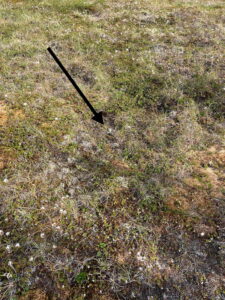
©Susan Scott
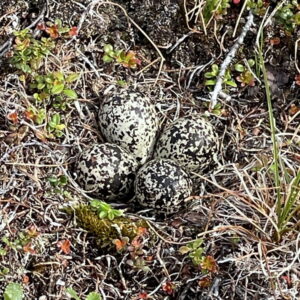
©Susan Scott
And on our last day, one of those nests produced the thrill of a lifetime for kōlea fans: two new hatchings and one pipping (and peeping) egg. The first tiny hatchling was already running around the nest.
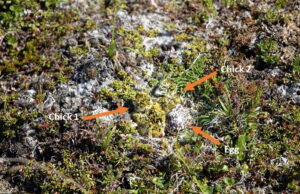
©Laura Doucette
Like chickens, kōlea parents don’t feed their offspring. As soon as hatchlings’ downy feathers are dry, the kids are out and about, foraging for insects and berries. Parents follow the best they can, warming and protecting the chicks as needed.
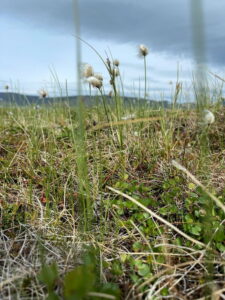
Wally posed this question: If we tall humans have a hard time finding a nest, how do little birds do it? This photo, taken by me on my belly, as Wally suggested, is a kōlea-eye view of the tundra. ©Susan Scott
In this bug-filled, light-all-night environment, chicks grow up fast. In one month, baby plovers can fly. Parents fly south in August, leaving their offspring on the tundra to fatten up as long as food is available. That can last into October, or even November, depending on weather. When snow falls, the summer’s chicks migrate to warm wintering grounds, instinct being their only guide.
This was the Hawaiʻi Audubon Society’s second trip to Nome with Wally, his study partners, and our outstanding guide, Carol Gales of Roam Nome. As a bonus this year, we crossed paths on the tundra with three Boston-based shorebird researchers, who, of course, knew Wally. The scientists came in from their field camp that evening to hear Wally’s kōlea talk, and share a special kōlea cake.
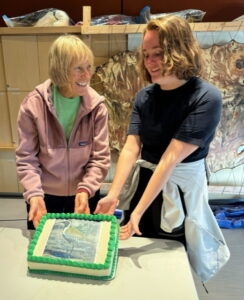
Thanks to KCC Professor Dr. Wendy Kuntz’s thoughtfulness, KCC student Charlotte Bender (right) and me celebrated our June birthdays in style with a preordered surpriskōlea cake. ©Susanne Hammer
Getting to see plover research in action with Wally Johnson and his colleagues was a true gift to all, as well as a rare education opportunity for our four Kapiolani Community College students.
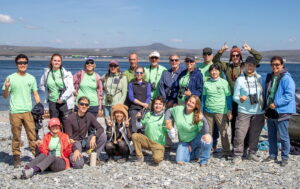
Our happy team in our kōlea team T-shirts under the Alaska blue sky. ©Laura Doucette
I still miss my kōlea on morning walks, but that empty feeling eases when I picture my birds sitting on speckled eggs, or chasing rambunctious chicks. I’m confident that I speak for all participants in offering our heartfelt thanks, and a fond chu-WEET, to Wally Johnson and all the others who made this remarkable trip possible.
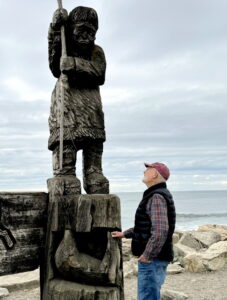
Warm aloha to Dr. Wally Johnson (here at the Welcome-to-Nome statue) for generously sharing his knowledge and study methods. ©Susanne Hammer
P.S. As you might imagine, Hawaiʻi Audubon-sponsored visits in Nome are expensive, involve a head-swimming amount of organization, and are risky weather-wise. (Cold wind and sideways rain could make kōlea viewing impossible.) When it works, though, it’s the experience of a lifetime.
To help us plan for a possible future Nome trip next June, please let us know if you’re interested by emailing office@hiaudubon.org
Shared with aloha, Susan Scott